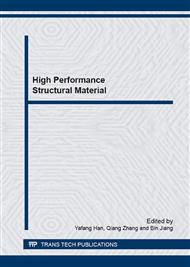p.682
p.688
p.694
p.699
p.705
p.711
p.715
p.722
p.729
Effect of HA Content on Microstructure and Compression Properties of Ti-Nb-Sn/HA Composites Fabricated by Plasma Current Activated Sintering
Abstract:
Novel bio-composites were synthesized by plasma current activated sintering from the Ti-35Nb-2.5Sn/HA powders ball-milled for 12 h. The aim of this study was to investigate the effects of HA content (5, 10 and 15 wt%) on sintering properties, microstructure and compression properties of Ti-35Nb-2.5Sn/HA bio-composites. Results indicated that sintering rate decreased slightly with the increase of HA content. The phases of sintered composites were mainly˰ڂ˽̤̹˼˰̘̑˼˰Ca3(PO4)2(TCP), TiO2, CaTiO3 and TixPy. The grain size of sintered composites reduced with the increasing of HA content, and sintered composites with ultra fine grains were fabricated finally. The compression test showed that all the sintered composites had low elastic modulus and high compression strength. The elastic modulus of Ti-35Nb-2.5Sn/15HA sintered composites was 22GPa with a high strength of 877MPa.
Info:
Periodical:
Pages:
705-710
Citation:
Online since:
April 2015
Authors:
Price:
Сopyright:
© 2015 Trans Tech Publications Ltd. All Rights Reserved
Share:
Citation:


